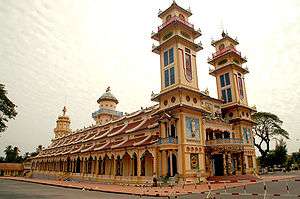Tây Ninh
| Tây Ninh, Vietnam Thành phố Tây Ninh | |
|---|---|
| Provincial City | |
|
Tây Ninh Holy See of the Cao Đài faith | |
| Coordinates: 11°22′4″N 106°07′8″E / 11.36778°N 106.11889°E | |
| Country |
|
| Province | Tây Ninh |
| Area | |
| • Total | 140 km2 (50 sq mi) |
| Population (2013) | |
| • Total | 153,537 |
| • Density | 1,100/km2 (2,800/sq mi) |
| Time zone | ICT (UTC+07) |
Tây Ninh, Vietnam (![]() listen) is a provincial city in south-western Vietnam. It is the capital of Tây Ninh Province, which encompasses the town and much of the surrounding farmland. Tây Ninh is approximately 90 km to the north-west of Ho Chi Minh City, Vietnam's largest city. As of 2013, the city had a population of 153,537, and a total area of 140 km².[1]
listen) is a provincial city in south-western Vietnam. It is the capital of Tây Ninh Province, which encompasses the town and much of the surrounding farmland. Tây Ninh is approximately 90 km to the north-west of Ho Chi Minh City, Vietnam's largest city. As of 2013, the city had a population of 153,537, and a total area of 140 km².[1]
The city is most famous for being the home of the Cao Đài religion, an indigenous Vietnamese faith that includes the teachings of the major world religions. The Cao Đài religion's Holy See, built between 1933 and 1955, is located around 5 km to the east of Tây Ninh's city centre.
History
After the Fall of Saigon, the town of Tây Ninh was reorganized to comprise 3 wards and 1 commune. In August 2001, the town was expanded to include 5 wards and 5 communes. On 29 December 2013, Tây Ninh town was upgraded officially to provincial city status, under administration of Tây Ninh Province, along with the upgrade of its two communes Ninh Sơn and Ninh Thạnh to ward status.[1]
Administrative division
Tây Ninh, Vietnam town comprises 7 wards (phường) and 3 communes (xã):
- Ward 1
- Ward 2
- Ward 3
- Ward 4
- Hiệp Ninh Ward
- Ninh Sơn Ward
- Ninh Thạnh Ward
- Bình Minh Commune
- Tân Bình Commune
- Thạnh Tân Commune
The ward is further divided into quarters (khu phố) and the commune into hamlets (ấp).
References
- 1 2 "Resolution on establishing Tay Ninh City". Tay Ninh Portal. Retrieved 9 Feb 2014.
Coordinates: 11°22′4″N 106°07′8″E / 11.36778°N 106.11889°E
Template:Districts of south-east Vietnam

